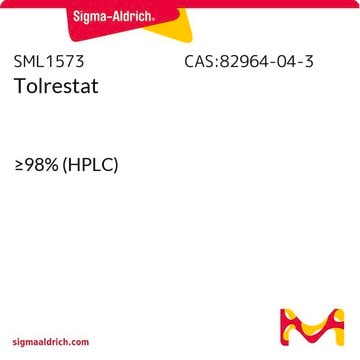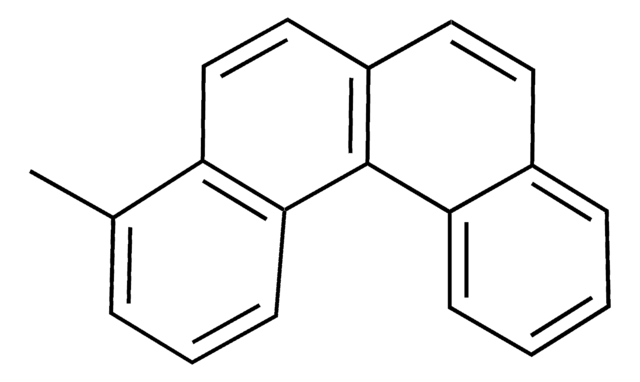推荐产品
质量水平
方案
≥98% (HPLC)
表单
powder
储存条件
protect from light
颜色
yellow to orange
溶解性
DMSO: 5 mg/mL, clear (warmed)
储存温度
−20°C
SMILES字符串
S1\C(=C/C(=C/c2ccccc2)/C)\C(=O)N(C1=S)CC(=O)O
InChI
1S/C15H13NO3S2/c1-10(7-11-5-3-2-4-6-11)8-12-14(19)16(9-13(17)18)15(20)21-12/h2-8H,9H2,1H3,(H,17,18)/b10-7+,12-8-
InChI key
CHNUOJQWGUIOLD-NFZZJPOKSA-N
应用
Epalrestat has been used as an aldose reductase inhibitor:
- in the dahomey larvae diet fed forDrosophila
- for non-irradiated and X-ray irradiated human aldose reductase
- to test its protective effect in mice with bleomycin-induced pulmonary fibrosis
生化/生理作用
Epalrestat inhibits Aldose Reductase (AR) involved in the rate limiting step in the conversion of glucose to sorbitol under hyperglycemic conditions. Aldose reductase has been the target of multiple clinical investigatons to treat diabetic neuropathy and retinopathy. Epalrestat is an approved drug in Japan and India, used for the treatment of diabetic neuropathy.
Epalrestat is an Aldose Reductase inhibitor.
特点和优势
This compound is featured on the Dopamine and Norepinephrine Metabolism page of the Handbook of Receptor Classification and Signal Transduction. To browse other handbook pages, click here.
其他说明
Light sensitve
储存分类代码
11 - Combustible Solids
WGK
WGK 3
闪点(°F)
Not applicable
闪点(°C)
Not applicable
历史批次信息供参考:
分析证书(COA)
Lot/Batch Number
其他客户在看
J W Steele et al.
Drugs & aging, 3(6), 532-555 (1993-11-01)
Epalrestat is a carboxylic acid derivative which inhibits aldose reductase, an enzyme of the sorbitol (polyol) pathway. Under hyperglycaemic conditions epalrestat reduces intracellular sorbitol accumulation, which has been implicated in the pathogenesis of late-onset complications of diabetes mellitus. Epalrestat 150
Mary Ann Ramirez et al.
Pharmacotherapy, 28(5), 646-655 (2008-05-02)
Diabetic neuropathy is one of the most common long-term complications in patients with diabetes mellitus, with a prevalence of 60-70% in the United States. Treatment options include antidepressants, anticonvulsants, tramadol, and capsaicin. These agents are modestly effective for symptomatic relief
Feyzi Sinan Tokalı et al.
Drug development research, 83(3), 586-604 (2021-09-30)
A series of novel sulfonates containing quinazolin-4(3H)-one ring derivatives was designed to inhibit aldose reductase (ALR2, EC 1.1.1.21). Novel quinazolinone derivatives (1-21) were synthesized from the reaction of sulfonated aldehydes with 3-amino-2-alkylquinazolin-4(3H)-ones in glacial acetic acid with good yields (85%-94%).
Zhen-Yu Li et al.
The American journal of Chinese medicine, 41(4), 801-815 (2013-07-31)
The lignan extracts from the tree bark of Eucommia ulmoides Oliv., a famous traditional Chinese medicine, have been demonstrated to have inhibitory effects on aldose reductase activity in spontaneously hypertensive rat myocardium. This study was aimed to investigate the hypertensive
Bruno Bulic et al.
Neuropharmacology, 59(4-5), 276-289 (2010-02-13)
Alzheimer disease is characterized by pathological aggregation of two proteins, tau and Abeta-amyloid, both of which are considered to be toxic to neurons. In this review we summarize recent advances on small molecule inhibitors of protein aggregation with emphasis on
我们的科学家团队拥有各种研究领域经验,包括生命科学、材料科学、化学合成、色谱、分析及许多其他领域.
联系客户支持














